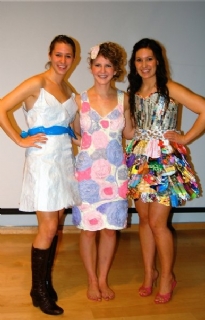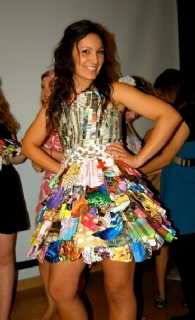Trash Our Runway
November 4, 2009
 On Oct. 9 there was standing room only in the Richard E. Peeler Art Center auditorium. The enthusiastic audience was there to see the first annual Trash Our Runway: A Recycled Fashion Show Contest. The event was co-sponsored by DePauw Environmental Club and Student Arts Council.
On Oct. 9 there was standing room only in the Richard E. Peeler Art Center auditorium. The enthusiastic audience was there to see the first annual Trash Our Runway: A Recycled Fashion Show Contest. The event was co-sponsored by DePauw Environmental Club and Student Arts Council.
Inspired by the popular television show, Project Runway, Carolyn M. Tubekis ’10 developed the DePauw version of the fashion show with an environmental focus. “The purpose of the event was to spread a message about sustainability and to challenge students to think about where their clothes come from,” Tubekis says.
Project Runway is a reality television show for fashion designers who are looking to make their break into the fashion industry. The contestants are often restricted in time, theme and materials. Their fashions are judged - resulting in elimination of one or more designers each week.
Trash Our Runway was similar in that student designers were restricted in the materials chosen. All of the materials had to be recyclable and re-used – nothing new could be used, to create a wearable garment. As the models walked down the runway, music blared, and a panel of three DePauw faculty members judged the completed fashions. 
The panel included Anne F. Harris, associate professor of art and chair of the Art Department; Kaytie A. Johnson, director and curator of University galleries, museums and collections; and Carol S. Steele, associate dean of academic affairs and sustainability coordinator.
Tubekis and event coordinator Jessica Adele Kane ’12 were also designers for the contest. “We get used to being stuck in a market where everything is made for us,” Kane says. “This experience was empowering. It made us more aware that clothing can be made from recycled things.”
Materials used in the designs included newspapers, magazines, hubcaps, old t-shirts, plastic bags, cardboard, discarded neon duct tape, film canisters and film negatives. “One of our goals for this event was to have fun. It was incredible to see almost posh, couture designs made of recycled materials – or trash! The designers took something ordinary and made it extraordinary,” Tubekis says.
“One of our goals for this event was to have fun. It was incredible to see almost posh, couture designs made of recycled materials – or trash! The designers took something ordinary and made it extraordinary,” Tubekis says.
The designs were judged based on creativity, craftsmanship, environmental consciousness and presentation. The first place winner was Brianna L. Schmall ’11 (at left), who designed a dress made out of cereal boxes, magazines and plastic grocery store bags. Stacie M. Grissom ’11, who used old t-shirts and tied them into rosebuds to make a dress, won second place. Kelsey T. Floyd ’12 and Kane were third place winners with a dress constructed of plastic trash bags that they ironed together.
Schmall didn’t have much prior experience as a seamstress, but her creativity and perseverance contributed to her first place win. “My main challenge was that I didn't know how to make a dress form,” Schmall says. “It was definitely a lot of trial and error as far as the fitting went. I thought the event went really well. It's great to see people come to events that support student art.” Her winning dress will be on display in the Peeler Art Center.
“This was indeed a great endeavor by the students: I loved the energy, good humor and goodwill of all the students involved,” Harris says. “DePauw is at its best when student initiatives thrive, and Trash Our Runway articulated a great set of ideas: artistic ingenuity, cultural know-how and environmental consciousness.
Our Runway articulated a great set of ideas: artistic ingenuity, cultural know-how and environmental consciousness.
“I often think of the liberal arts education as training students (and professors) to come up with complex solutions to the world's complex problems,” Harris says. “Global warming is about as complex as it gets in terms of politics, science and culture, and seeing the disciplines of art, fashion and industry brought together in this show was one of a great many welcomed steps in moving environmental concerns into popular culture.”